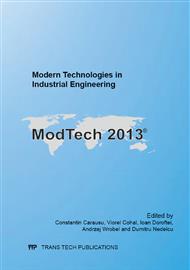p.624
p.628
p.634
p.639
p.645
p.651
p.657
p.663
p.669
CFD Study on must of Grapes Separation in a Hydrocyclone
Abstract:
Abstract. Hydrocyclones are increasingly used in the food industry for various separation and purification. In this paper, an optimization was made to design a hydrocyclone model using CFD (Computational Fluid Dynamics). CFD simulation is performed with FLUENT software by coupling the Reynolds Stress Model (RSM) for must of grapes flow with Discrete Phase Model (DPM) for solid particles trajectory. Coupling of discrete phase (particles) and continuous phase (must of grapes) in the mathematical model is set so that the continuous phase to influence discrete phase. Tracking particles traiectory in this hydrocyclone allows advanced degree is separation so obtained to the maximum particle size approaching the size of a yeast cell 10 μm, without separating them. Hydrocyclone dimensional designed simulation was performed and analyzed on an experimental pilot plant for three different must flow rates supply. Introduced particle flow rates simulation and experiment does not exceed 10% of the must flow rates. The degree of separation obtained is in agreement with experimental data.
Info:
Periodical:
Pages:
645-650
Citation:
Online since:
November 2013
Authors:
Price:
Сopyright:
© 2014 Trans Tech Publications Ltd. All Rights Reserved
Share:
Citation:


